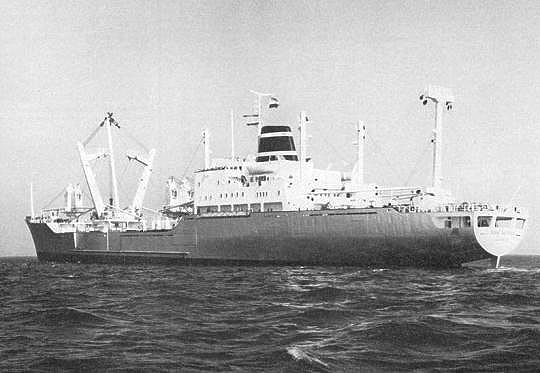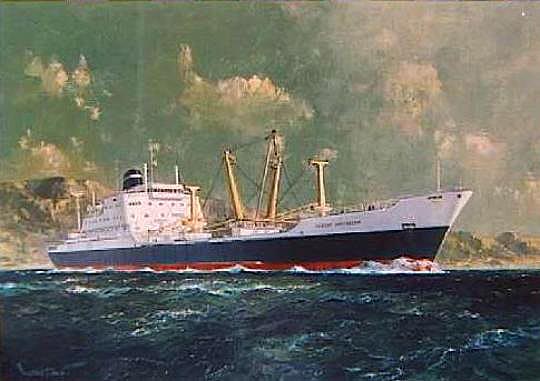
![]()
ms Trident Amsterdam
The building of a ship starts with making a general drawing according to the owners' wishes. After many discussions the design is finalised and detailed drawing of every part of the ship are maid. These drawings are necessary for the actual shipyard builders to construct the vessel exactly as specified. An interesting and difficult process which requires a lot of coordination during the building phase. Also in the final drawing state we received two copies of the General Plan and the lay outs of the radio room and wheelhouse. The latter for planning the installation of the radar indicators, echo sounding equipment and others if ordered with us. In the New Building Department of Radio Holland Rotterdam, in which I worked, the draughtsman and I added in the General Plan the radio receiving and transmitting aerials, the radar antenna in the mast on top of the wheelhouse and all other aerials which were part of our supplied equipment. We also indicated the location of the echo sounder's transducer in the bottom of the ship. We also sent all required detailed cable plans to the company who was appointed to carry out the cabling work. The shipyard translated our drawings into shipyard drawings with which the shipyard builders could work and sent it back to us for approval. This was tricky for if anything was found to be wrong later on the yard would claim the extra work to us. A real cliff hanger, as such costs could run up very high.
The reason why explain this process in some details is that in this case we came later on in rough weather because of the position of the radar antenna. As can be seen in the picture below the ship carried on the fore ship a so called Stülcke mast. A radar antenna should be positioned in such a way that the low side of the emitted energy bundle will reach the water right in front of the bow at a distance of three ship lengths. During the discussions with the shipyard we pointed out this requirements. But the yard commented that this would make the mast on top of the wheelhouse much too long. We argued that this would give rise to problems later on and that things would cost more to correct the situation, but to no avail. We then confirmed it in writing and sent it to the yard who never responded. The fuse was lit at that moment and things exploded when the radar antenna was already installed by us. We got blamed but we could produce the letter sent to the yard. On top of that the yard also had written down our advice in the minutes which were made up of such meetings. The fury of the owners than turned to the shipyard who had to make costly amendments to the mast's construction. However, the required three ship lengths rule was never reached, but the Governmental Shipping Inspection Department seemed to have accepted the situation.

This is the ms Trident Amsterdam, call sign PIAP, which changed to PJOU in 1970 when brought under the flag of the Netherlands Antilles. Note the very obstructive Stülcke mast on the fore ship. With help of this construction the ship is able to load and unload heavy cargo by itself. Especially handy when you touch small ports in South America without big crane facilities. This ship is a sister ship of the ms Trident Rotterdam which was delivered in 1971.
The ms Trident Amsterdam was built in 1970 by the Dutch shipyard P. Smit Jr. Machinefabriek & Shipyard, Rotterdam, Netherlands, as new build 644. The launching took place on 29 April, 1970 and the delivery to the Owners Koninklijke Nederlandse Scheepvaart Maatschappij on 8 October, 1970.
Technical details:
Gross tonnage: 10.841
Nett tonnage: 5.941
Deadweight: 9.312
Type: Freighter with accommodation for 12 passengers, and a crew of 30.
Speed: 21 knots
LxWxH (1970): 169,09 x 24,06 x 12,50
Draft: 8,24 m
Main engine: 8 cylinder Sulzer diesel, 16.000 Hp
Time Line:
1970 (8 October) ms TRIDENT AMSTERDAM delivered to the owners Koninklijke Nederlandsche Stoomboot Maatschappij
N.V., Amsterdam, Netherlands.
1970-1979 msTRIDENT AMSTERDAM sailing under ownership of the N.V. West-Indische Scheepvaart
Maatschappij, Willemstad, Netherlands Antilles.
1979 (September) The Trident service was cancelled and the ship was renamed to ms
AMSTERDAM.
1979 (August) - 1981 The ms AMSTERDAM now owned by the N.V. West-Indische Scheepvaart
Maatschappij, Willemstad, Netherlands Antilles.
1981(May) - 1982 Because of the merger of several Dutch shipping companies the
vessel is now owned by Nedlloyd Lijnen B.V., Willemstad, Netherlands
Antilles, and renamed to ms WILLEMSTAD.
1982 (January) - 1984 Once more the ownership is changed to Nedlloyd Lijnen B.V.,
Willemstad, Netherlands Antilles, and renamed to ms NEDLLOYD WILLEMSTAD,
1984-1986 New owners are Nedlloyd Lijnen, Rotterdam, Netherlands, and the
vessel is renamed to ms NEDLLOYD WILLEMSTAD.
1986-1987 Sold to Mercury Lake Inc. (Mercury Shipping Co. Ltd.), Hong Kong
and renamed to ms ACACIA II,
1987-1992 Same owners but vessel is renamed to ms ALAMANDA.
1992 Vessel is sold to the breakers in India. Arrival at the ship killing fields
of Port Alang, India, on 20 July 1992.

An artist impression of the
ms Trident Amsterdam. Artist unknown.